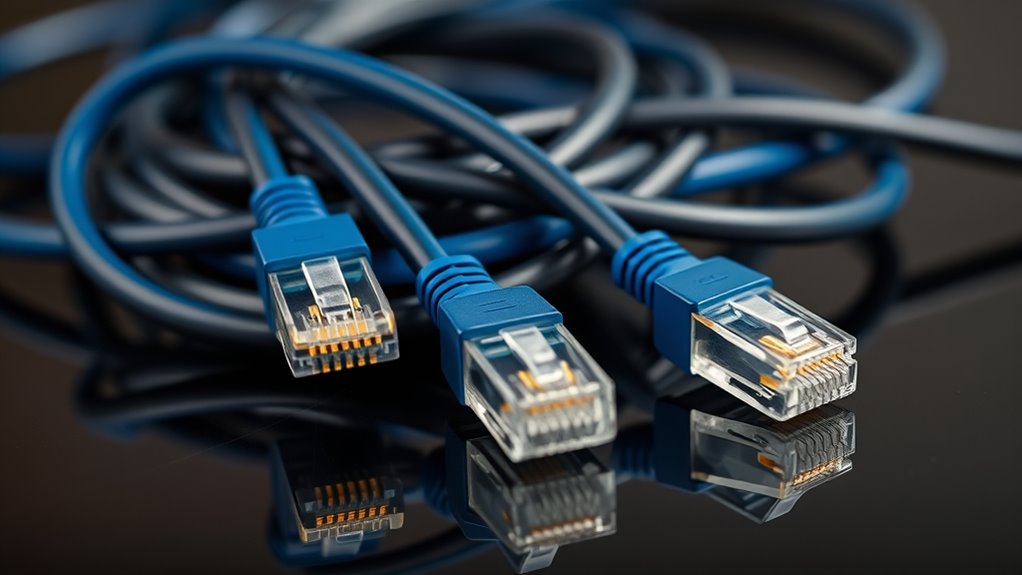If you’re considering Cat7 or Cat8 cables, you’ll find they offer high speeds, superior shielding, and long-lasting durability, making them ideal for demanding environments like data centers or enterprise networks. While the initial cost is higher, their enhanced performance and future-proof features often justify the investment. If you want to make the most informed choice, you’ll discover key differences and tips that can help you decide which cable best fits your needs.
Key Takeaways
- Cat7 and Cat8 cables provide significantly higher data transfer speeds and better shielding, ideal for high-demand environments.
- They are more expensive but offer improved durability, interference resistance, and future-proofing for evolving network standards.
- Best suited for data centers, enterprise networks, and short-range high-speed setups where reliability is critical.
- Compatibility issues may arise with older equipment, potentially requiring hardware upgrades for optimal performance.
- Overall, their advanced features justify the investment for critical, high-performance, and future-ready network infrastructure.
Understanding the Differences Between Cat7 and Cat8
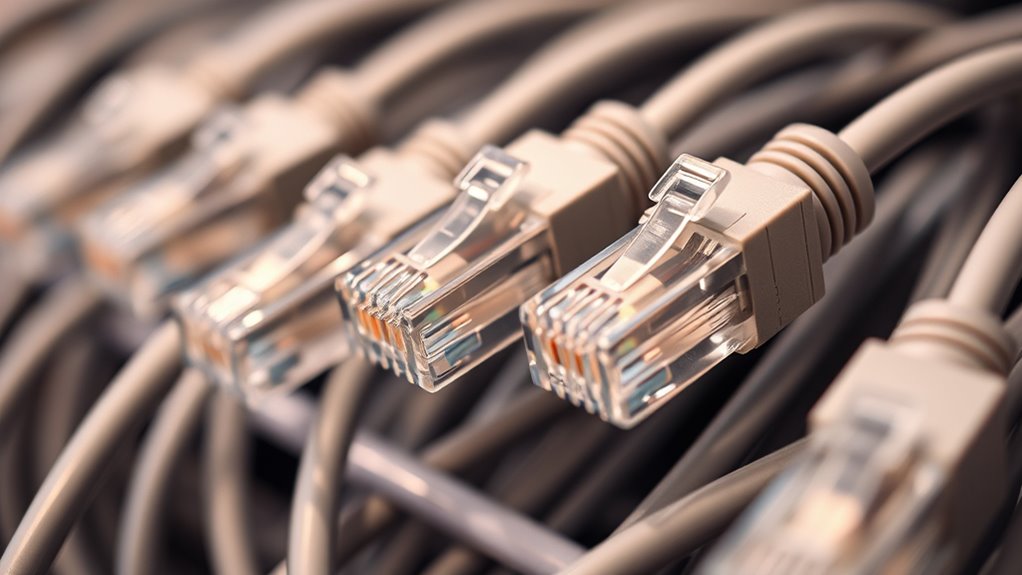
Although both Cat7 and Cat8 cables are designed for high-speed data transmission, they differ markedly in performance and application. Cat8 offers faster speeds and better shielding, making it ideal for data centers and demanding environments. In contrast, Cat7 is more versatile for longer-distance runs and offers reliable performance at lower cost. When considering alternatives, fiber optic cables provide even higher speeds and longer ranges, though they require different installation methods. Wireless alternatives, such as Wi-Fi 6, eliminate cables altogether, offering convenience and mobility. Your choice depends on your specific needs: if you prioritize speed and minimal interference, Cat8 is a solid pick, but for broader coverage and flexibility, fiber optic or wireless options might be better suited. Furthermore, understanding fandom’s evolution can help you make more informed decisions about technology use and infrastructure.
Performance and Speed Capabilities

When it comes to performance and speed, Cat8 cables clearly outperform Cat7. They support data transfer rates up to 40 Gbps and bandwidths reaching 2 GHz, making them ideal for demanding applications. Unlike fiber optic options, which excel in long-distance, high-speed data transmission, Cat8 is optimized for short-range, high-performance setups. You’ll notice faster file transfers, smoother streaming, and lower latency. For comparison, wireless alternatives may offer convenience but often lag behind in speed and stability. Additionally, bandwidth capacity plays a crucial role in handling multiple high-demand devices simultaneously. Proper shielding and construction also help maintain optimal performance in high-frequency environments, ensuring reliable data transmission. Moreover, understanding cabling standards can help determine the best setup for your specific needs, especially in environments that require interference mitigation to ensure data integrity.
Shielding and Interference Resistance
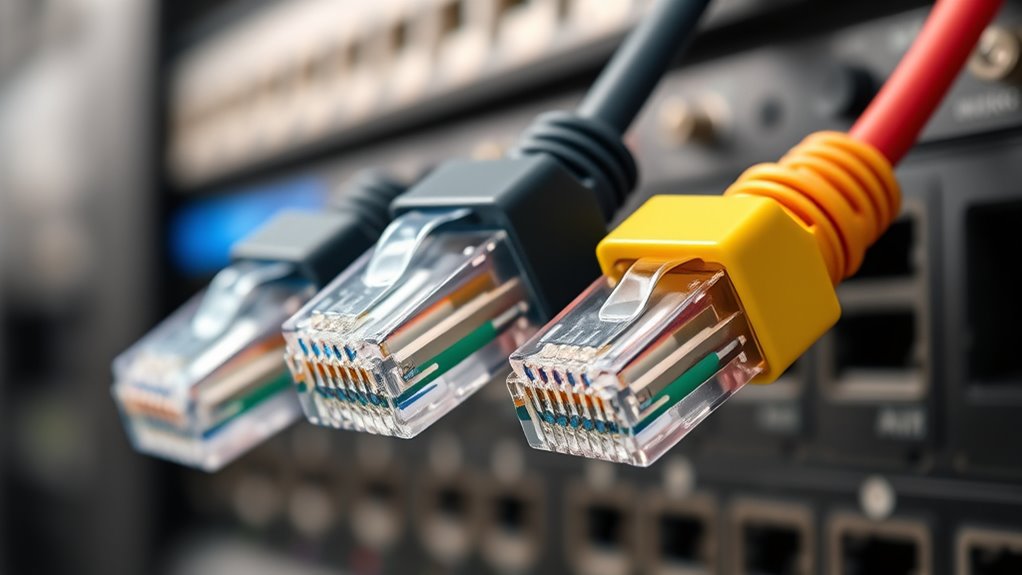
Shielding plays a crucial role in enhancing the interference resistance of Cat7 and Cat8 cables. These cables incorporate advanced shielding methods, aligning with high Ethernet standards, to protect data transmission from electromagnetic interference (EMI) and radio frequency interference (RFI). This shielding improves cable durability by reducing wear caused by external factors, ensuring consistent performance even in noisy environments. Different shielding types, like foil or braided shields, offer varying levels of protection and flexibility. Here’s a quick comparison:
| Shielding Type | Interference Resistance | Cable Durability |
|---|---|---|
| Foil Shield | High | Moderate |
| Braided Shield | Very High | High |
| No Shield | Low | Lower |
| Overall Shield | Maximum | Very High |
| Combination | Prime | Very High |
Choosing the right shielding enhances Ethernet standards compliance and extends cable longevity. Additionally, selecting cables with appropriate shielding can help meet regional regulations and standards, ensuring reliable network performance.
Compatibility With Existing Equipment

Before upgrading to Cat7 or Cat8 cables, you need to check if your current network devices and ports support these standards. Using incompatible equipment can cause downgrade issues or limit performance. Make certain connectors and ports match to guarantee seamless integration and ideal network speed. Compatibility with existing equipment is essential to prevent technical issues. Ensuring network equipment compatibility can save time and avoid potential frustration during setup. Additionally, verifying the cable specifications of your current devices can help determine if the new cables will function correctly and provide the optimal data transfer rates. Knowledge of store hours can help plan when to purchase new networking equipment or accessories to ensure compatibility.
Compatibility With Network Devices
Although Cat7 and Cat8 cables offer advanced performance, their compatibility with existing network devices varies. Many older devices may not support these high-speed standards or require adapters. When considering compatibility, pay attention to:
- The port types on your switches and routers
- Support for higher frequencies and shielding
- Whether your devices can handle the bandwidth
- Cable aesthetics and how they blend with your setup
- Color coding, which helps identify cable types quickly
While these cables often use standard connectors like RJ45, some may have specialized connectors or unique shielding that could complicate integration. Ensuring your current equipment supports the specifications of Cat7 or Cat8 is essential for seamless compatibility and maximum network performance. Additionally, understanding the compatibility of your existing hardware can help prevent costly upgrades or connection issues. Recognizing the prophetic nature of technology limitations can also guide smarter purchasing decisions.
Downgrade Risks and Limitations
Upgrading to Cat7 or Cat8 cables can introduce significant compatibility challenges with your existing network equipment. These cables often require specialized connectors and higher-quality ports, which your current setup may lack. Additionally, their increased power consumption can strain older hardware, leading to potential performance issues or the need for upgrades. This can result in hardware incompatibility, making it difficult to integrate these cables seamlessly into your current network infrastructure. This not only impacts your network’s efficiency but also has an environmental impact, as older devices may consume more energy or become obsolete faster. Moreover, the higher frequency of Cat7 and Cat8 cables can encounter interference issues with less advanced equipment, reducing overall network reliability. You might face limitations in scaling your network or integrating new technology without investing in compatible hardware. Before upgrading, evaluate whether your existing equipment can handle the increased demands to avoid costly setbacks and ensure your network remains stable and efficient, especially considering the compatibility limitations that come with higher-category cables.
Connector and Port Compatibility
Connector and port compatibility is a critical factor to contemplate when upgrading to Cat7 or Cat8 cables, as these cables often require specialized connectors like GG45 or RJ45 with enhanced shielding. Ensuring your existing equipment supports these connectors is essential for seamless port interoperability. Without proper compatibility, you might face connection issues or need costly adapter solutions.
Consider these points:
- Compatibility with existing RJ45 ports or need for adapters
- Support for GG45 or TERA connectors in your hardware
- Shielded connectors matching cable shielding standards
- Compatibility with network switches and patch panels
- Potential firmware updates for port recognition
- Networking standards help determine compatibility requirements for these advanced cables and connectors.
Checking connector compatibility beforehand prevents installation setbacks, ensuring your network maintains ideal performance with minimal disruptions.
Installation and Flexibility Considerations

When installing Cat7 and Cat8 cables, you need to carefully consider their flexibility and ease of handling. Cable flexibility affects how easily you can route cables through tight spaces or around corners, reducing installation complexity. Rigid cables may require extra effort and tools, increasing time and potential damage risks. To understand this better, consider the following:
| Flexibility Level | Installation Complexity |
|---|---|
| High | Easier, quicker setup |
| Moderate | Moderate effort, careful handling |
| Low | Difficult, prone to damage |
| Very Low | Significant planning needed |
| Very High | Simplifies complex runs |
Choosing a cable with appropriate flexibility guarantees smoother installation and fewer complications. Additionally, selecting cables with suitable shielding can improve signal integrity during installation. Being aware of installation best practices can further ensure a successful setup and long-term performance. Proper planning and understanding of cable specifications can also help prevent potential issues during installation.
Cost Analysis and Value for Money

Investing in Cat7 and Cat8 cables involves weighing their higher performance against their costs, as these premium cables typically come with a steeper price tag than earlier Ethernet standards. When doing a cost comparison, you’ll notice the initial investment is higher, but the value assessment can justify it if you need top-tier speed and reliability. Consider factors like:
- Better shielding reducing interference
- Higher data transfer rates
- Longer lifespan and durability
- Future-proofing for advanced networks
- Reduced need for upgrades soon
While the upfront cost is significant, these cables can save you money in the long run by delivering consistent performance and minimizing network issues. Additionally, compatibility and standards compliance are important to ensure your network equipment can fully leverage the capabilities of Cat7 and Cat8 cables. Moreover, understanding the Mazda tuning principles can help you optimize your vehicle’s performance, similar to how selecting the right Ethernet cables can enhance your network infrastructure. If your setup demands high speed and stability, the extra expense could be well worth it. A thorough cost analysis helps determine whether the investment aligns with your long-term networking goals.
Typical Use Cases and Scenarios
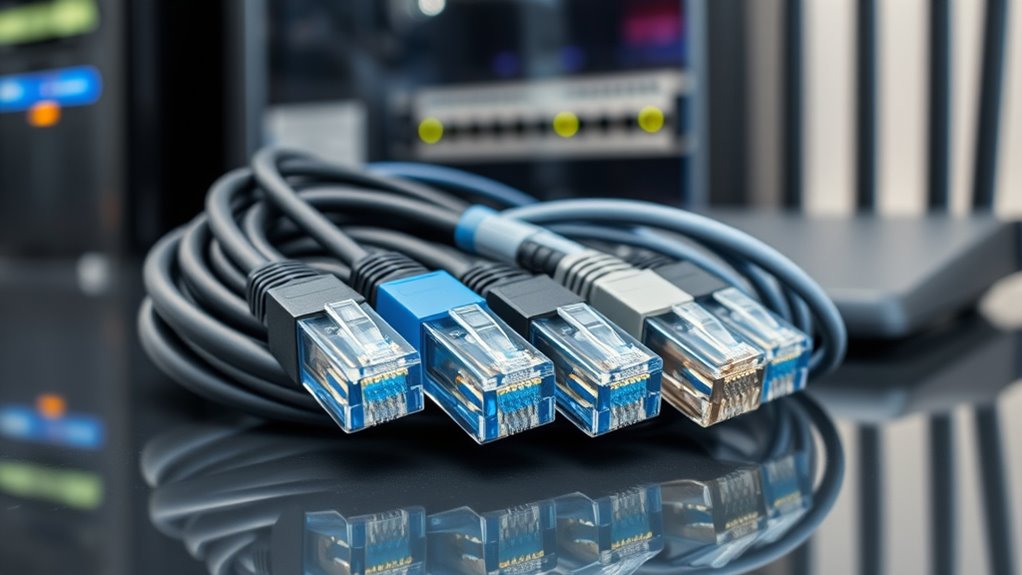
Cat7 and Cat8 cables are ideal for high-performance environments that demand maximum speed and reliability, such as data centers, server rooms, and enterprise networks. You’ll find these cables useful when handling large data transfers, hosting critical applications, or supporting high-bandwidth devices. They’re especially suitable where fiber optic connections aren’t practical or too costly. While fiber optic offers superior long-distance performance, Cat7 and Cat8 excel in short-range, high-speed scenarios. Wireless alternatives may seem tempting for convenience, but they often lack the stability and bandwidth needed for demanding setups. Use these cables when you require consistent, ultra-fast connections that fiber optics or wireless options can’t easily match in a confined space. They’re essential for environments where performance is non-negotiable.
Longevity and Future-Proofing
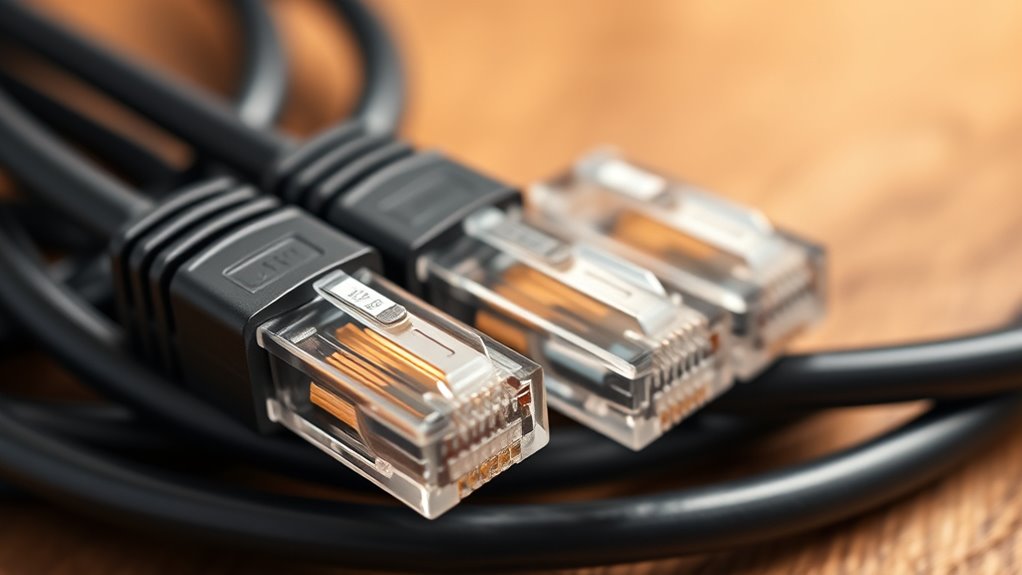
Thanks to their advanced shielding and high-quality materials, Cat7 and Cat8 cables are built to last, offering excellent durability in demanding environments. This means you benefit from improved future durability, guaranteeing your setup remains reliable over time. Their robust construction reduces wear from frequent plugging and unplugging, helping maintain peak performance. With tech longevity in mind, these cables support evolving network standards, making them a smart investment. You won’t need frequent replacements, saving money and hassle. Consider these key features:
- Superior shielding for protection against interference
- High-quality insulation resisting wear and tear
- Strong connectors for secure connections
- Resistance to environmental damage
- Compatibility with future network upgrades
This durability ensures your network stays resilient long-term, making Cat7 and Cat8 a future-proof choice.
Making an Informed Decision
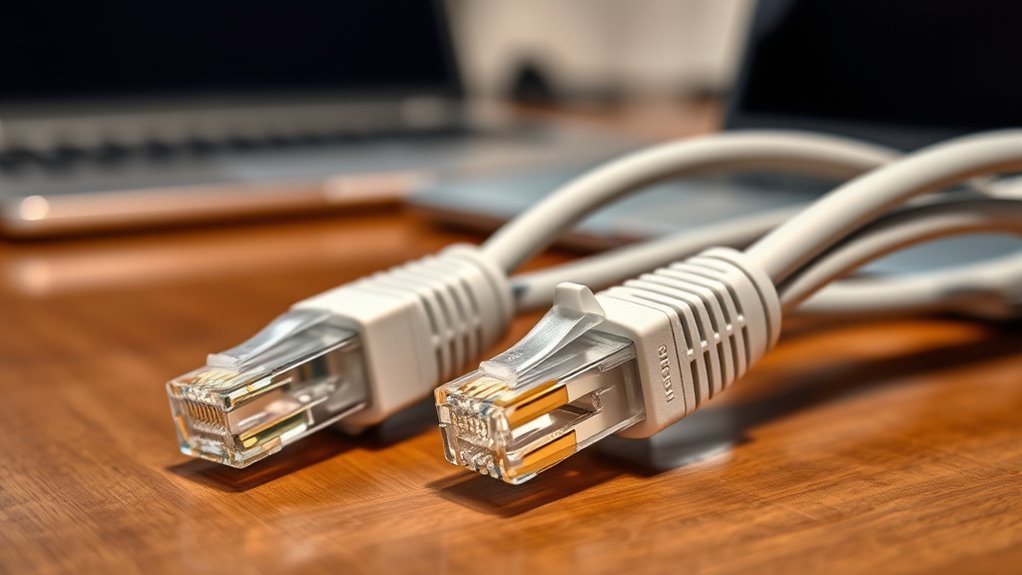
Choosing the right cable depends on understanding your specific needs and how each option aligns with your current and future network plans. If you require higher speeds and minimal interference, Cat8 cables might be worth the investment. However, consider fiber optics, which offer even greater bandwidth and longer distances without signal degradation. Wireless alternatives like Wi-Fi can be convenient for mobility but often lack the stability and speed of wired options. Evaluate your environment, budget, and performance expectations. For future-proofing, combining fiber optics with high-quality Ethernet cables can provide flexibility. Making an informed decision means weighing these factors carefully, ensuring your network setup can handle evolving demands while optimizing cost and performance.
Frequently Asked Questions
Do Cat7 and Cat8 Cables Require Special Connectors?
Yes, Cat7 and Cat8 cables require special connectors to guarantee peak performance. Their connector compatibility differs from standard Ethernet cables, often needing GG45 or RJ45 connectors designed for high-frequency signals. This can make installation more complex, as compatibility issues may arise if you don’t use the right connectors. To avoid problems, verify connector types beforehand and consider professional installation if needed, since proper connection is vital for performance.
How Do Environmental Factors Affect Cable Performance?
Environmental factors can subtly influence your cable’s performance. You might notice interference mitigation issues if cables are exposed to electromagnetic interference or physical obstructions. Temperature resilience is vital—extreme heat or cold can degrade signals and reduce longevity. To keep your network running smoothly, guarantee cables are installed in environments with stable temperatures and minimal interference, protecting your investment and maintaining peak performance over time.
Can Existing Ethernet Ports Support Cat7 or Cat8?
Your existing Ethernet ports may not support Cat7 or Cat8 cables because of port limitations. These high-speed cables often require specialized connectors and higher port compatibility, which standard ports might lack. Before upgrading, check your device’s Ethernet compatibility to guarantee it can handle the advanced specifications of Cat7 or Cat8. Otherwise, you might need to upgrade your network hardware for peak performance.
Are There Any Safety Concerns With High-Speed Cables?
Yes, there are safety concerns with high-speed cables like Cat7 and Cat8. You should be aware that electromagnetic interference can affect their performance, especially if they’re not properly shielded. Additionally, handling high-speed cables improperly, such as damaging the insulation, can pose safety risks, including electrical shocks. Always guarantee you install these cables following manufacturer guidelines to protect user safety and minimize electromagnetic interference issues.
How Easy Is It to Upgrade From Cat6 to Cat7 or Cat8?
Upgrading from Cat6 to Cat7 or Cat8 is like swapping out a bicycle for a race car—exciting but requiring careful preparation. You’ll need to check connector compatibility, as newer cables often use different connectors. The installation complexity can be moderate, involving potentially rerouting or replacing existing ports and ensuring your network hardware supports higher standards. With patience and the right tools, you’ll navigate this upgrade smoothly and enjoy blazing-fast speeds.
Conclusion
Deciding between Cat7 and Cat8 isn’t just about speed; it’s about anticipating what your setup will need tomorrow. Sometimes, the best choice surprises you, blending performance with cost. Whether you’re upgrading now or future-proofing, understanding these cables can lead to unexpected benefits. After all, in the world of tech, the right cable often makes all the difference—sometimes just when you least expect it.
